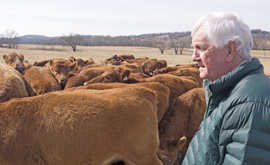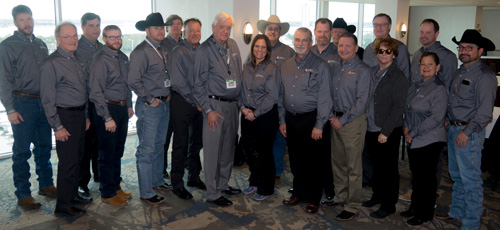
Phillip Ferrell (right), president of Agri-Sales and Jerry Bellar examine agency sales figures. Ferrell has guided Agri-Sales through the ever-changing market landscape and into the firm’s growing list of opportunities.
Ask Jerry Bellar what practices or principles have guided him and his agency through its more than 40-year history and chances are he’ll pepper his response with references such as:
- “You don’t know what you don’t know.”
- “Don’t be the first to try something new or put the old aside.”
- Quoting hockey great Wayne Gretzky: “I skate to where the puck is going to be, not where it has been.”
- And finally, “MANA has been a godsend to me and the agency.”
Bellar founded Agri-Sales Associates, Inc., Nashville, Tennessee, in 1976 in order to provide a national sales force of experienced, qualified manufacturers’ representatives for companies selling to the agricultural, lawn and garden, hardware and veterinary markets.
According to Bellar, “I began my sales career in 1961 primarily selling products to veterinarians.” When industry and business changes began affecting the company he was national sales manager for, he had to make a decision about the future. “I decided to go off on my own. I felt if I was going to succeed or fail, I would do it on my own.

Jackie and Jerry Bellar in front of Agri-Sales’ office located in a house that was originally the residence of the family that started Maxwell House Coffee after the turn of the 19th century. Jackie has been an integral part in building the business by running the office and operations and overseeing accounting.
“When I decided to become a rep, I have to admit I really didn’t know what one was. I only knew one rep and he was working with just one principal. Luckily when I quit my former job, they gave me a six-month termination so I was able to get started — accompanied by four managers who previously worked for me. Shortly after deciding to become a rep, the 3M Company contacted me and said they wanted me to rep their just-starting vet product lines. I remember the first product we started with was leg wraps for horses.”
With that as the beginning, the company now has a staff of 22 people in the field with a goal of adding six to eight people this year. (The process of finding the right people to work for an agency was covered last month in Agency Sales.) As to how he’s approaching that task, Bellar says, “We primarily depend on references that we receive from others. Keep in mind that we sell to every distributor that deals in animal health products. When you’ve been in the sales business and the industry as long as I have, you develop a lot of contacts and those contacts become especially valuable at this time.” He adds that presently his goal is to hire from the millennial generation, e.g., people right out of college. “As an example, I’ve recently heard about a prospect from the dean of a local agricultural school. He let me know he knew of a prospect with a great deal of potential.”
As to his desire to hire from among millennials, Bellar explains, “Young people think and communicate differently from others. That’s something we’re trying to capitalize on.”

The main office staff, from left side, clockwise, Justin Gersman, Sheila Groves, Jackie Bellar, Jerry Bellar, Phillip Ferrell, Grace Page and Brenda Jenkins (not pictured Joe Elcan and David Simmons).
When he speaks about the task of hiring new people, Bellar notes that for anyone anticipating a career as a manufacturers’ rep, “They’ve got to be told that it’s still a lot of hard work and demands a lot of travel. What they’ve got to be able to do is prove they can do the job. For anyone willing to take it on, however, the rewards can be considerable.”
Probably related to that desire to work with others who think and communicate differently, Bellar continues that one of the current goals of Agri-Sales is to make efficient use of social media. “The key to effectively using social media is to have just one person in your organization in charge of it. If you leave it up to me, I’ll probably say or do something wrong. That’s why we have one person in charge.”
As an example, he cites the use of social media in the organization’s efforts to promote one their principal’s rodent-control products via LinkedIn and Facebook. In addition, he notes that his sales staff have been able to gain a presence in social media groups related to honeybees. “There have been widespread reports on the threats to honeybees, an insect that humans depend upon for any number of reasons. Taking part in various discussion groups allows us to communicate the value of some of the products we represent.”
If the prevalence of social media in the business world is one change that has affected the daily lives of manufacturers’ representatives, Bellar notes that there have been others. “In our industry especially, we’re faced with the drastic consolidation of customers. At one time we had 40-50 distributors that we sold to. Now we’re dealing with two major buying groups. The majority of buying decisions are now made in locations in Colorado and Idaho, and that’s where we have to focus our efforts.”

Jared Givens, one of the agency’s regional managers, demonstrates the features and benefits of the one-piece Y-Tex ear tag to two farmers at the recent FBA tradeshow. The firm has represented Y-Tex for more than 30 years. The agency’s sales force attends or supports several hundred tradeshows per year, both large and small.
In addition to social media Bellar cites the impact of communication changes in general. “Think for a moment about the impact that the iPhone has had in just the last 20 years. Obviously, its impact can be a positive or a negative if we don’t change how we serve the customer.”
And serving the customer is the last major change he cites. “It used to be the function of the manufacturers’ rep to provide knowledge to the customer. The customer can locate that knowledge himself today. Now our job is to show them how they can use that knowledge.”
Bellar doesn’t necessarily view the aforementioned changes as problems that cause him to stay awake at night. But when he does address possible problems that might affect his agency, that’s when he speaks about the dangers of not knowing what you don’t know and the need to skate where the puck is going to be. “Look at what Uber and Lyft have done to the taxi industry. No one anticipated their impact. In our industry we’re looking at the real possibility of drones delivering products. In addition, I don’t know what the future holds for the brick-and-mortar stores we sell to. What I do know, however, is that there will always be a role for us. Customers need products and we all have to eat. There will always be a role for the independent manufacturers’ rep in our industry.”
Finally, as he reflects on his agency’s 36-year membership in MANA (“MANA has been a godsend for us.”), Bellar explains, “I’ve been a member of MANA for so long, I forget how I first heard about the association. One thing I do remember, however, is that at the beginning I simply didn’t know what a rep was. What I did was to take advantage of what the association had to offer. I attended some meetings, and probably 90 percent of my agency structure and contracts I work with have been copied from MANA. And, to this day I make sure Agency Sales is sent to all of our people.”
Any doubt that Agri-Sales has truly put to use what it’s learned from MANA can be put to rest by a simple visit to the agency’s website (www.agri-sales.com). It’s there that the primary reasons MANA espouses for working with independent manufacturers’ representatives are published — and bear repeating as follows.
10 Advantages of Using a Rep Group
Selling through agencies is not for every manufacturer; but it is the most efficient method of moving goods and services known, and it currently produces an estimated $250 billion of the nation’s gross national product.
It is a sales method in which you only pay for results. It may well be just what your company needs to boost sales and profits in today’s business climate.
1. Provides predictable sales costs.
The manufacturer and agent agree in advance on a set commission which remains the same for the life of the agreement, in good times or bad. Knowing up front that your cost of sales is a fixed percentage of the unit price eliminates many planning and pricing headaches.
2. Lower sales costs.
What does the average direct sales employee cost a company? Let’s add it up. Start with a base pay of $55,000. Now add the cost of automobile and travel expenses, insurance benefits, stock and profit sharing plans, sick leave, vacation and holiday pay and per diem expenses. Current estimates put this at $40,000 to $50,000.
Now add in payroll taxes, workers comp insurance, bonding fees, liability insurance, etc. These are an additional $30,000 to $35,000 over and above the salesman’s base salary and maintenance costs.
Altogether this average salesperson is costing you $125,000 to $140,000 per year. The question is, what is he bringing back for you?
3. Reduces administrative overhead.
With an outside salesforce, the constantly escalating costs of administrating sales payroll and furnishing various administrative services for sales employees is reduced significantly, even eliminated in some cases!
4. Eliminates costs of training and turnover in sales personnel.
Whenever you hire new sales employees you start paying them immediately, but they don’t start paying off for you until much later, if at all. There is no way to recover the sales that they miss during all these transitions. But you can avoid losing them in the first place by using a trained and established salesforce for hire.
5. Gives immediate access to the market.
With the agency, manufacturers have an experienced sales team in the territory immediately. The agency people will be very familiar with the area and have a number of good prospects that they feel would be ready to consider your product line.
6. Provides a highly experienced, more aggressive sales force.
Surveys show that today’s agent is highly educated and trained and was a sales manager or a senior salesperson before going on his own to establish or work for an agency. Since there is no base salary to rely on, agents can’t afford to slack off at any time; they must sell to live, and therefore must make sales time count — for both the principal and the agency.
7. Provides sales forecasting equal or superior to a direct sales force.
Sales forecasting is as good or better with an agent since an agent tends to know his market better than anyone. Also, since the agent is only paid a percentage of the sales they generate, those forecasted numbers are very important to them. In fact many of today’s agents use sales analysis and forecasting methods which are often more sophisticated than those of the manufacturers they represent.
8. Provides a broader sales context for your product.
Because he sells several related but non-competing product lines, the agent is in a position to expose you to a wider variety of prospects and customers. By doing this he often finds applications for your products which would be missed by the single-line salesperson.
9. Adds marketing flexibility at less cost.

Even when he’s away from the office, Jerry Bellar isn’t far from work. On a recent visit to his farm, he’s accompanied by several of his beef cattle, all of whom sport ear tags from one of the agency’s longest-standing vendors, Y-Tex, Cody, Wyoming.
Sales agents can increase your volume by selling outside your present marketing territory — and you’ll pay them a commission only when they produce. Agents can also sell a new line without conflicting with your present sales organization. There are numerous ways that a manufacturers’ agent can fit into your marketing picture. Many companies use both direct salespeople and agents and find that the two sales forces are complementary.
10. Increase sales.
Many manufacturers switching from direct sales employees to agents have enjoyed increased sales and lowered costs. It has been estimated that the individual agent sells approximately 70 percent more than the average company salesman — due in part, no doubt, to his independent status and a greater need to succeed.
MANA welcomes your comments on this article. Write to us at [email protected].


